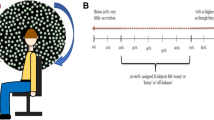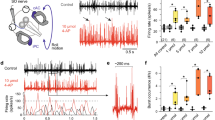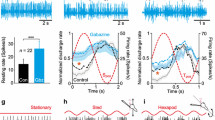Abstract
The transfer characteristics of the vestibuloocular reflex (VOR), and of the semicircular canal primary afferents (SCPAs) that drive it, have been studied in several species. In monkeys and cats, the dominant time constant describing horizontal VOR dynamics (τ hu ) is longer than that (τ c ) of horizontal SCPAs. This lengthening of the time constant has been attributed to a “velocity storage” mechanism that has been modeled as a positive feedback loop in the VOR pathways. We have studied the transfer characteristics of horizontal and vertical VOR and SCPAs in unanesthetized pigeons. In this species the dominant time constants of both the horizontal and vertical VOR (τ hv and τ vv ) are shorter than τ c . This finding indicates that time constants characterizing the lower frequency response of the VOR can be lengthened or shortened depending on the species. We propose that in the pigeon the “velocity leakage” mechanism can be modeled by substituting negative feedback for positive feedback in the model of the VOR pathways. Negative feedback can also account for the further shortening of τ hu and τ vv as VOR gain increases with arousal. Additionally, making the negative feedback loop nonlinear can model the dependency of lower frequency VOR phase on amplitude, and skew in VOR waveforms. Pigeon VOR and SCPA dynamics also differ in their adaptive properties and higher frequency behavior. A predominance of input from highly adaptive SCPAs is proposed to account for the increased adaptation of the vertical VOR as compared with SCPAs overall. A pure time-delay associated with VOR operation can explain the phase lag of the VOR relative to SCPAs at higher frequencies.
Similar content being viewed by others
References
Anastasio TJ (1991) Neural network models of velocity storage in the horizontal vestibulo-ocular reflex. Biol Cybern 64:187–196
Anastasio TJ, Correia MJ (1988) A frequency and time domain study of the horizontal and vertical vestibuloocular reflex in the pigeon. J Neurophysiol 59:1143–1161
Anastasio TJ, Correia MJ, Perachio AA (1985) Spontaneous and driven responses of semicircular canal primary afferents in the unanesthetized pigeon. J Neurophysiol 54:335–347
Arends JJA, Zeigler HP (1991) Organization of the cerebellum in the pigeon Columba livia, I. Corticonuclear and corticovestibular connections. J Comp Neurol 306:221–244
Baloh RW, Kimm J, Hassul M (1983) A comparison of the dynamics of the rabbit and human vestibuloocular reflex. Exp Neurol 81:245–256
Brauth SE, Karten HJ (1977) Direct accessory optic projections to the vestibulo-cerebellum: a possible channel for oculomotor control systems. Exp Brain Res 28:73–84
Brecha N, Karten HJ, Hunt SP (1980) Projection of the nucleus of the basal optic root in the pigeon: an autoradiographic and horseradish peroxidase study. J Comp Neurol 189:615–669
Buettner UW, Büttner U, Henn V (1978) Transfer characteristics of neurons in vestibular nuclei of the alert monkey. J Neurophysiol 41:1614–1628
Büttner U, Waespe W (1981) Vestibular nerve activity in the alert monkey during vestibular and optokinetic nystagmus. Exp Brain Res 41:310–315
Correia MJ, Landolt JP, Ni M-D, Eden AR, Rae JL (1981) A species comparison of linear and nonlinear transfer characteristics of primary afferents innervating the semicircular canal. In: Gualtierotti T (ed) The vestibular system: function and morphology. Springer-Verlag, New York, pp 280–316
Correia MJ, Perachio AA, Eden AR (1985) The monkey vertical vestibuloocular response (VVOR): a frequency domain study. J Neurophysiol 54:532–548
Dickman JD, Correia MJ (1989a) Responses of pigeon horizontal semicircular canal afferent fibers, I. Step, trapezoid, and low-frequency sinusoid mechanical and rotational stimulation. J Neurophysiol 62:1090–1101
Dickman JD, Correia MJ (1989b) Responses of pigeon horizontal semicircular canal afferent fibers, II. High-frequency mechanical stimulation. J Neurophysiol 62:1102–1112
Donaldson IML, Knox PC (1990) Directionally-specific effects of afferent signals from the extraocular muscles upon responses in the pigeon brainstem to horizontal vestibular stimulation. Neuroscience 38:145–161
Egmond AAJ van, Groen JJ, Jongkees LBW (1949) The mechanics of the semicircular canal. J Physiol 110:1–17
Ezure K, Graf W (1984) A quantitative analysis of the spatial organization of the vestibulo-ocular reflexes in lateral-and frontal-eyed animals, I. Orientation of semicircular canals and extraocular muscles. Neuroscience 12:85–93
Fernandez C, Goldberg JM (1971) Physiology of peripheral neurons innervating semicircular canals of the squirrel monkey, II. Response to sinusoidal stimulation and dynamics of peripheral vestibular system. J Neurophysiol 34:661–675
Furman JM, O'Leary DP, Wolfe JW (1982) Dynamic range of the frequency response of the horizontal vestibulo-ocular reflex of the alert rhesus monkey. Acta Otolaryngol 93:81–91
Gioanni H (1988a) Stabilizing gaze reflexes in the pigeon (Columba livia), I. Horizontal and vertical optokinetic eye (OKN) and head (OCR) reflexes, Exp Brain Res 69:567–582
Gioanni H (1988b) Stabilizing gaze reflexes in the pigeon (Columba livia) II. Vestibulo-ocular (VOR) and vestibulo-collic (closed-loop VCR) reflexes. Exp Brain Res 69:583–593
Highstein SM (1973a) The organization of the vestibulo-oculomotor and trochlear reflex pathways in the rabbit. Exp Brain Res 17:285–300
Highstein SM (1973b) Synaptic linkage in the vestibulo-ocular and cerebello-vestibular pathways to the VIth nucleus in the rabbit. Exp Brain Res 17:301–314
Keller EL (1973) Accommodative vergence in the alert monkey. Motor unit analysis. Vision Res 13:1565–1575
Landolt JP, Correia MJ (1980) Neurodynamic response analysis of anterior semicircular canal afferents in the pigeon. J Neurophysiol 43:1746–1770
Letelier JC, Evinger C, Wallman J (1987) The soma-dendritic organization of physiologically characterized avian extraocular motoneurons. Soc Neurosci Abs 13:172
Lorente de Nó R (1933) Vestibuloocular reflex arc. Arch Neurol Psychiatr 30:245–291
Matsuo V, Cohen B (1984) Vertical optokinetic nystagmus and vestibular nystagmus in the monkey: up-down asymmetry and effects of gravity. Exp Brain Res 53:197–216
Mayne R (1950) The dynamic characteristics of the semicircular canals. J Comp Physiol Psychol 43:304–319
McKenna OC, Wallman J (1985) Accessory optic system and pretectum of birds: comparisons with those of other vertebrates. Brain Behav Evol 26:91–116
Melvill Jones G, Milsum JH (1970) Characteristics of neural transmission from the semicircular canal to the vestibular nuclei of cats. J Physiol (Lond) 209:295–316
Milsum JH (1966) Biological control systems analysis. McGraw-Hill, New York
Money KE, Sokoloff M, Weaver RS (1966) Specific gravity and viscosity of endolymph and perilymph. In: Second symposium on the role of vestibular organs in space exploration. Ames Research Center, NASA, Moffett Field, CA, SP-115, pp 91–98
Morgan B, Frost BJ (1981) Visual response characteristics of neurons in nucleus of basal optic root of pigeons. Exp Brain Res 42:181–188
Outerbridge JS (1969) Experimental and theoretical investigation of vestibularly-driven head and eye movement. Doctoral dissertation, McGill University, Montreal, Canada
Paige GD (1983) Vestibuloocular reflex and its interactions with visual following mechanisms in the squirrel monkey, I. Response characteristics in normal animals. J Neurophysiol 49:134–151
Raphan T, Cohen B (1981) Effects of gravity on rotatory nystagmus in monkeys. Ann NY Acad Sci 374:44–55
Raphan T, Matsuo V, Cohen B (1979) Velocity storage in the vestibuloocular reflex arc (VOR). Exp Brain Res 35:229–248
Robinson DA (1968) A note on the oculomotor pathway. Expl Neurol 22:130–132
Robinson DA (1976) Adaptive gain control of Vestibuloocular reflex by the cerebellum. J Neurophysiol 39:954–969
Robinson DA (1981) The use of control systems analysis in the neurophysiology of eye movements. Ann Rev Neurosci 4:463–503
Skavenski AA, Robinson DA (1973) Role of abducens neurons in Vestibuloocular reflex. J Neurophysiol 36:724–738
Thorson J, Biederman-Thorson M (1974) Distributed relaxation processes in sensory adaptation. Science 183:161–172
Waespe W, Henn V (1979) The velocity response of vestibular nucleus neurons during vestibular, visual, and combined angular acceleration. Exp Brain Res 37:337–347
Wilson VJ, Melvill Jones G (1979) Mammalian vestibular physiology. Plenum Press, New York
Winterson BJ, Brauth SE (1985) Direction-selective single units in the nucleus lentiformis mesencephali of the pigeon (Columba livia). Exp Brain Res 60:215–226
Young LR, Oman CM (1969) Model for vestibular adaptation to horizontal rotation. Aerospace Med 40:1076–1080
Author information
Authors and Affiliations
Rights and permissions
About this article
Cite this article
Anastasio, T.J., Correia, M.J. “Velocity leakage” in the pigeon vestibulo-ocular reflex. Biol. Cybern. 70, 235–245 (1994). https://doi.org/10.1007/BF00197604
Received:
Accepted:
Issue Date:
DOI: https://doi.org/10.1007/BF00197604




